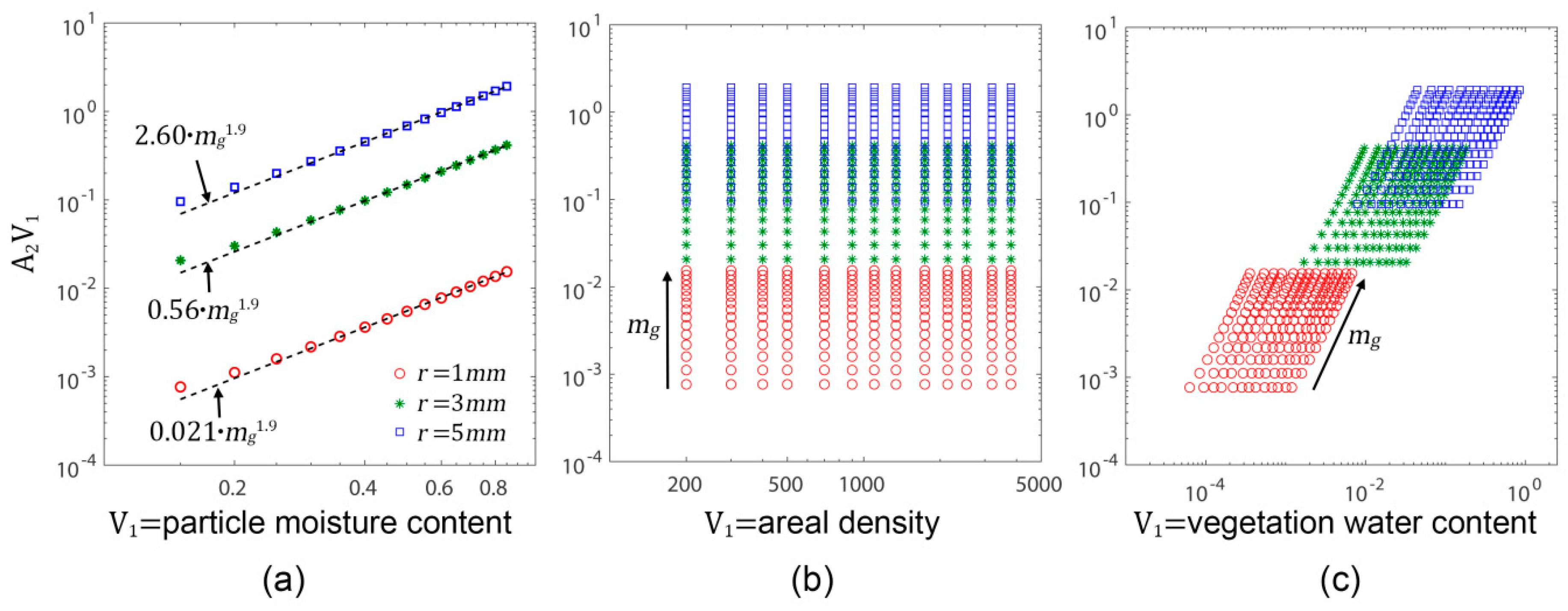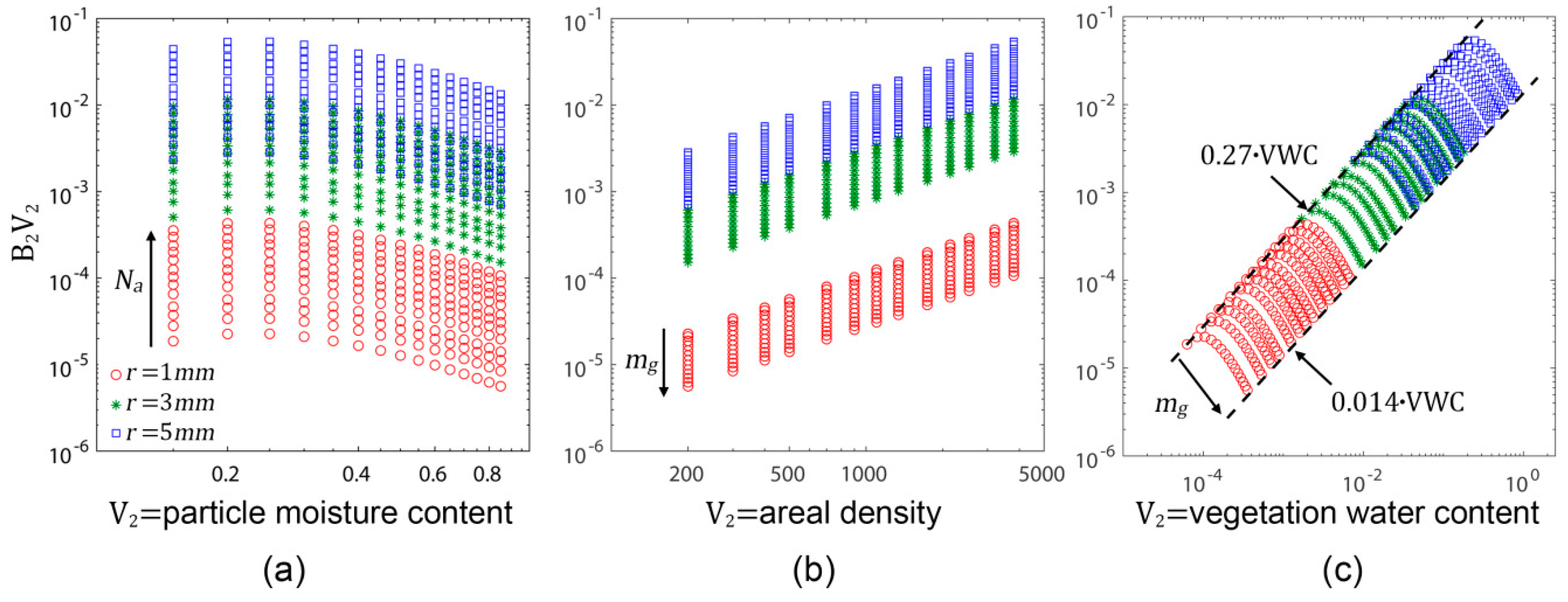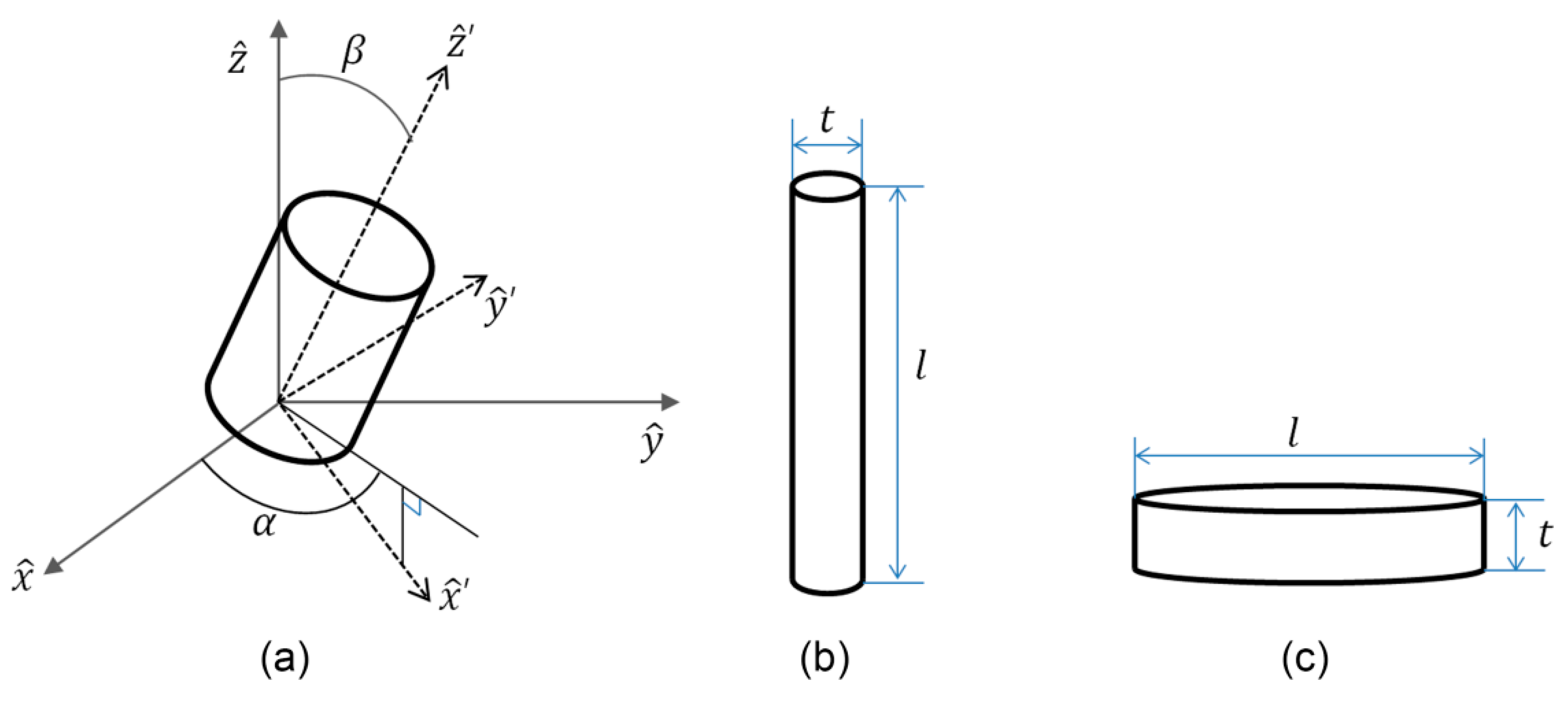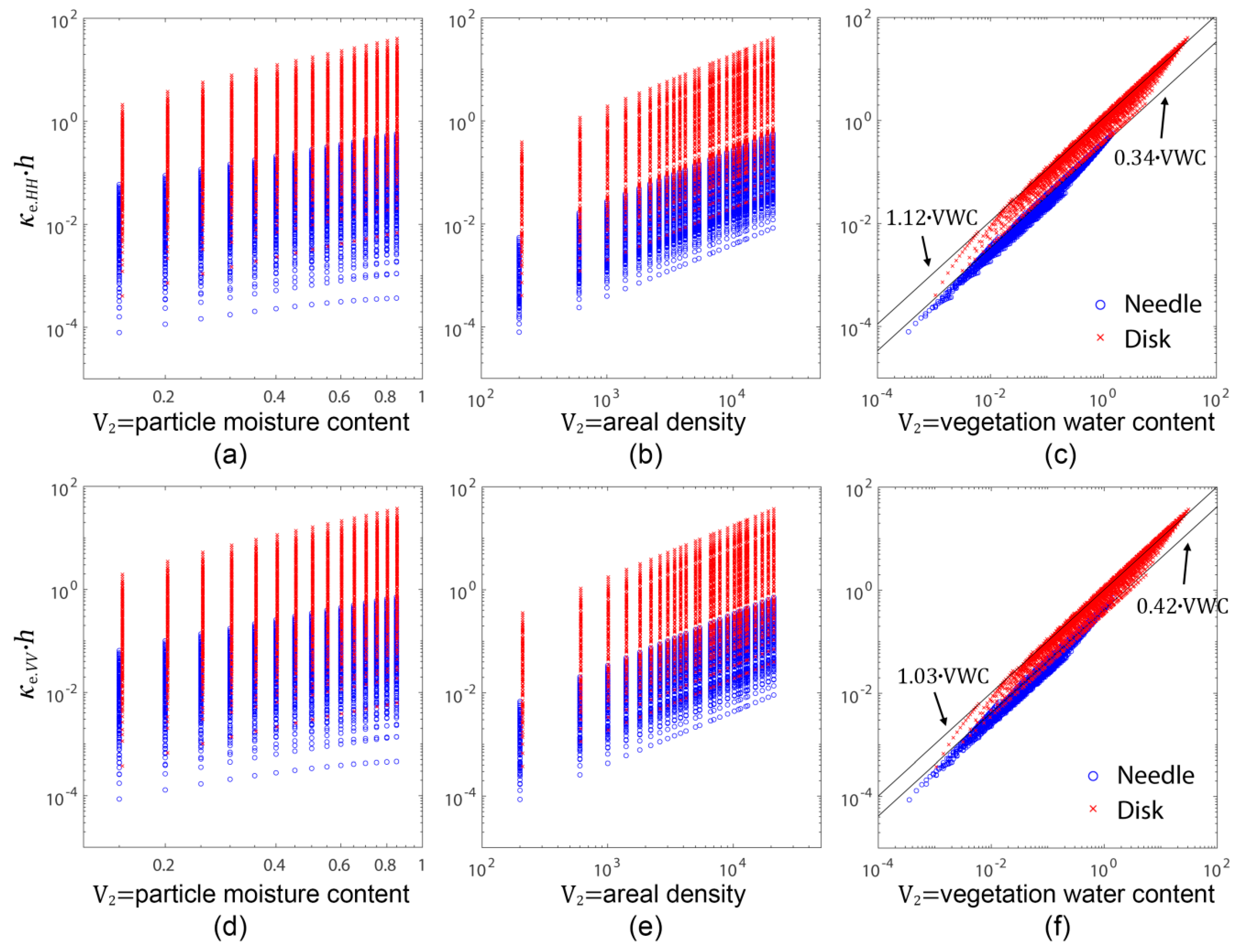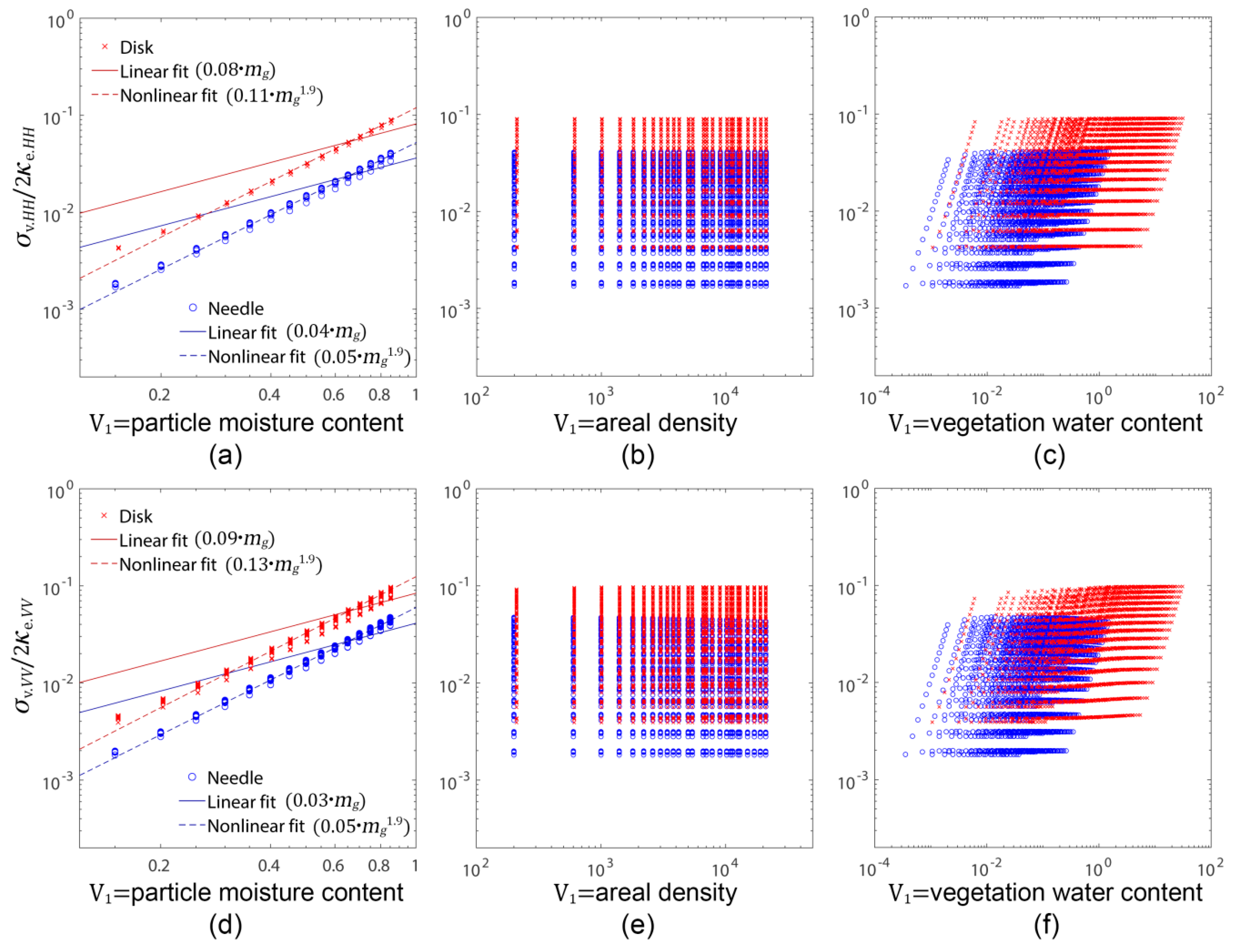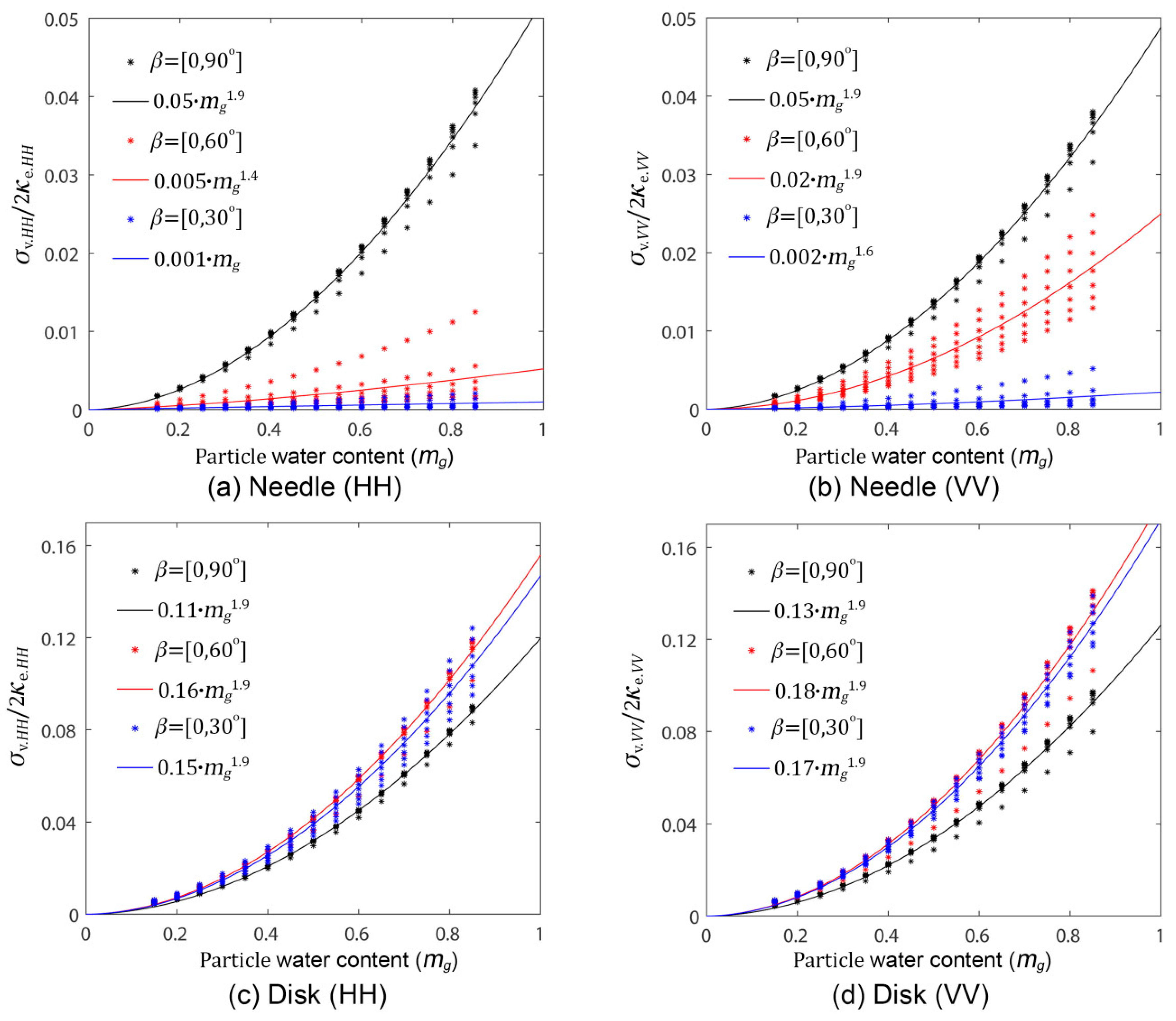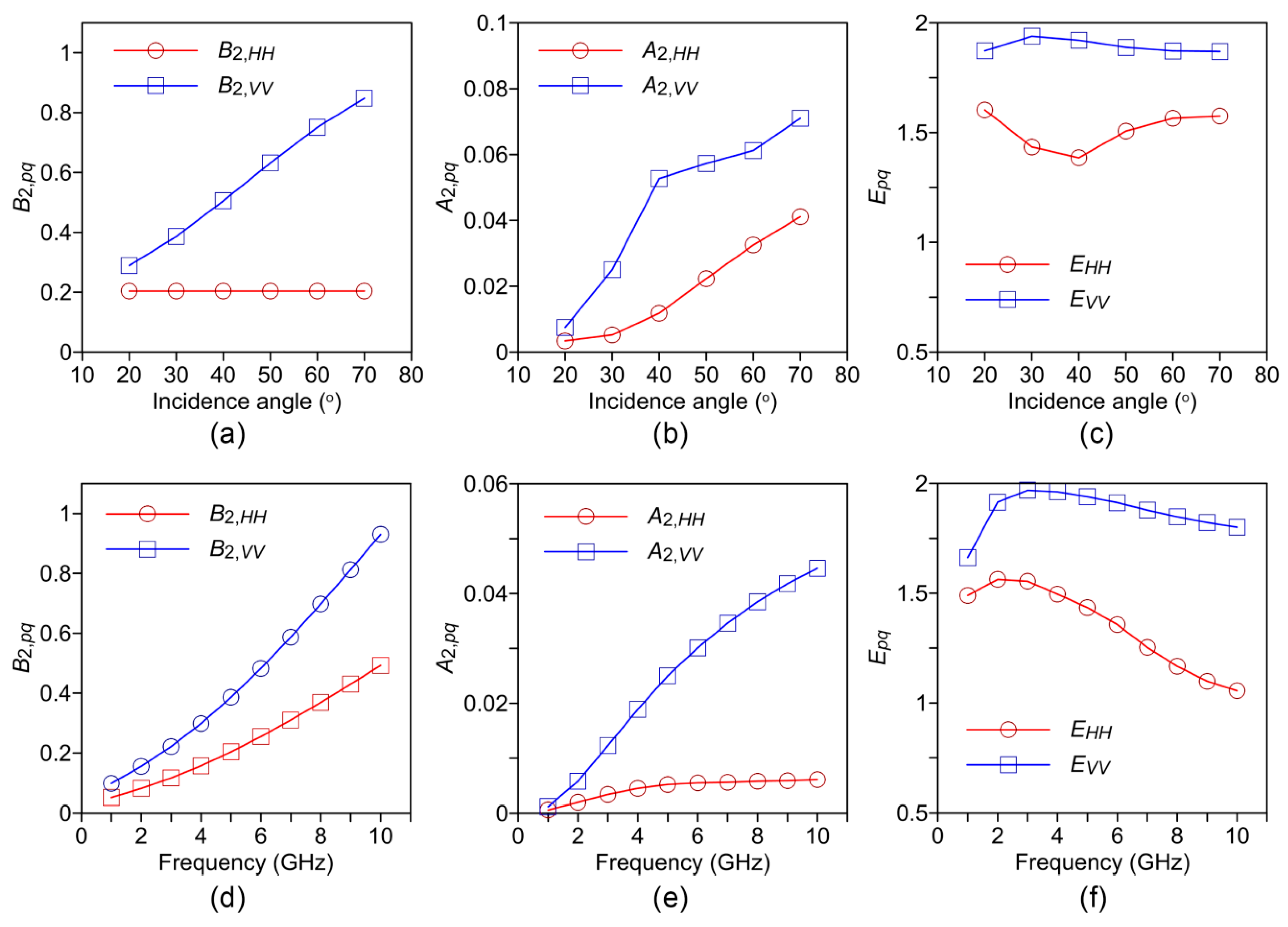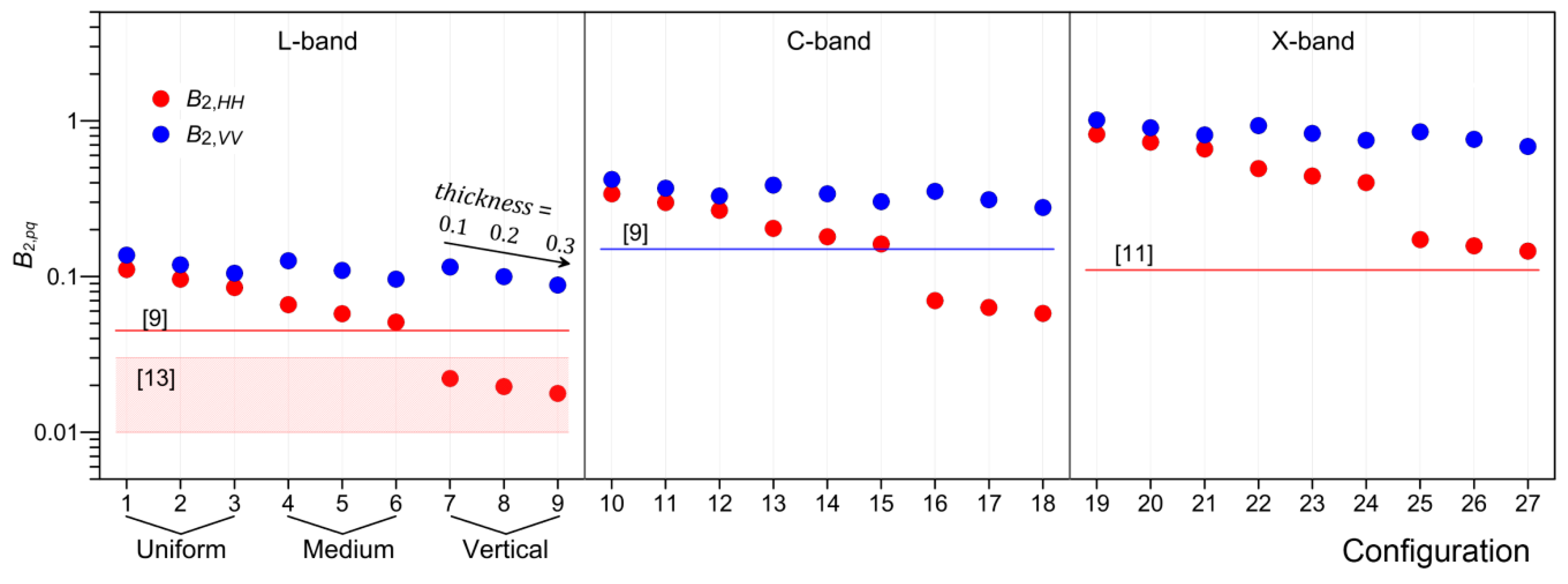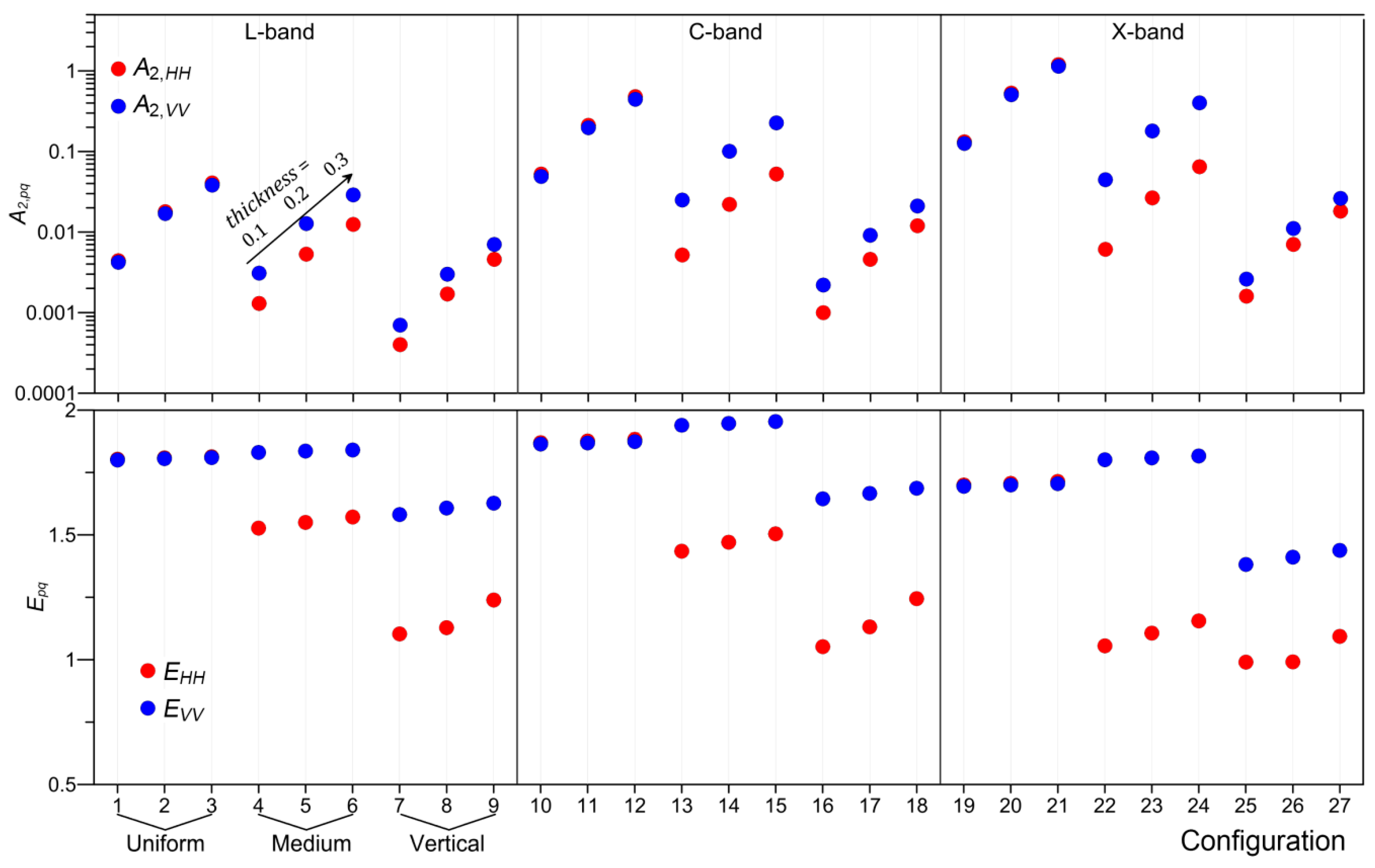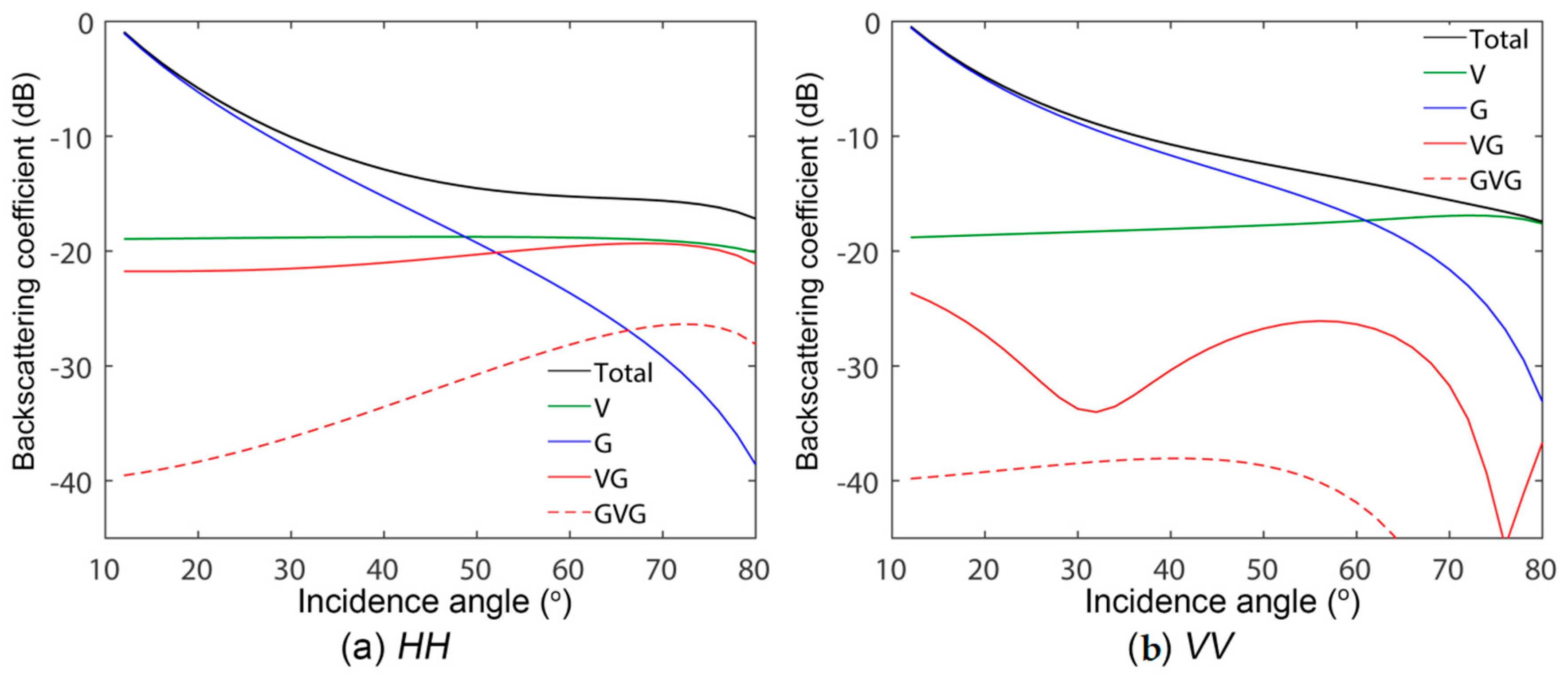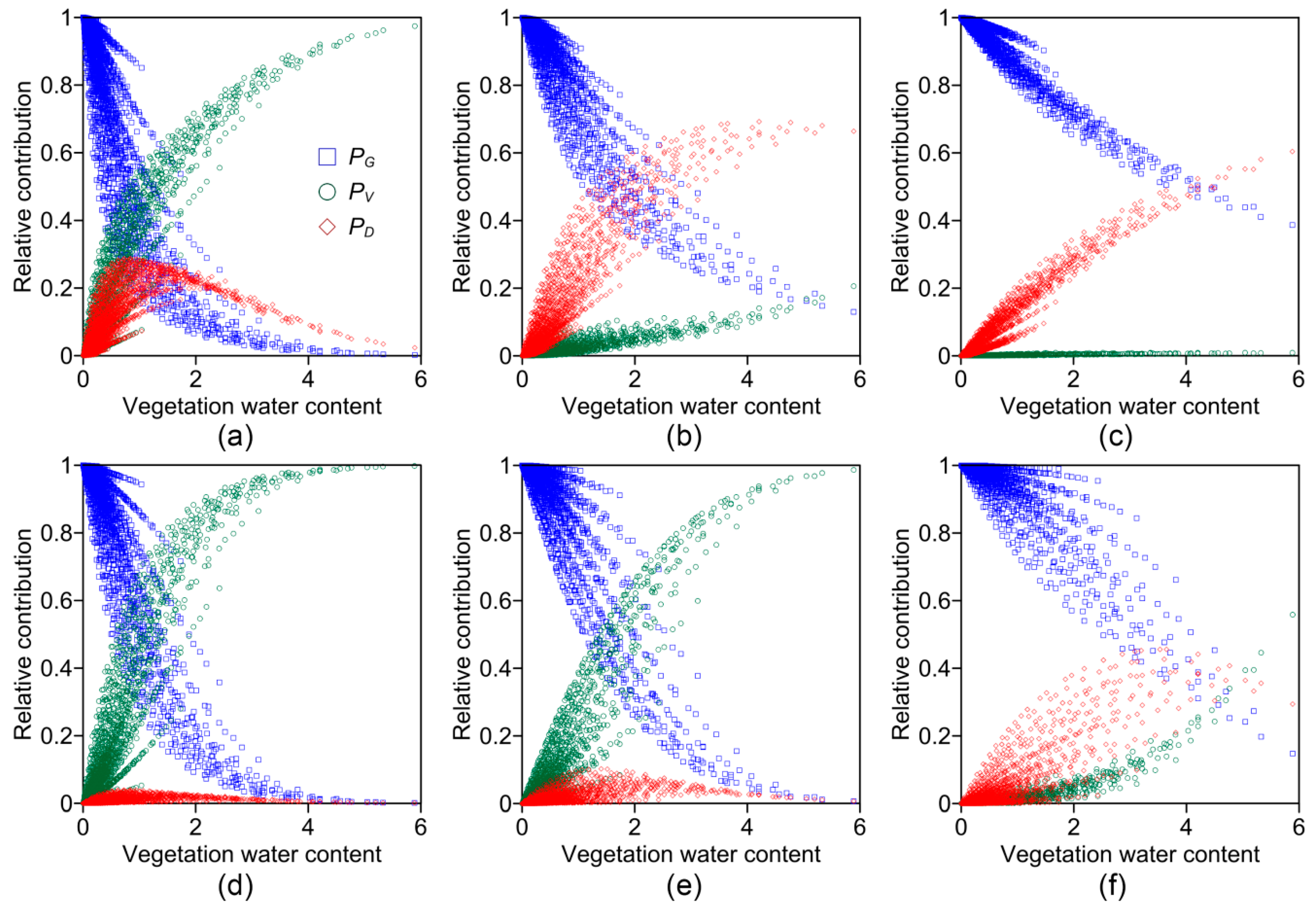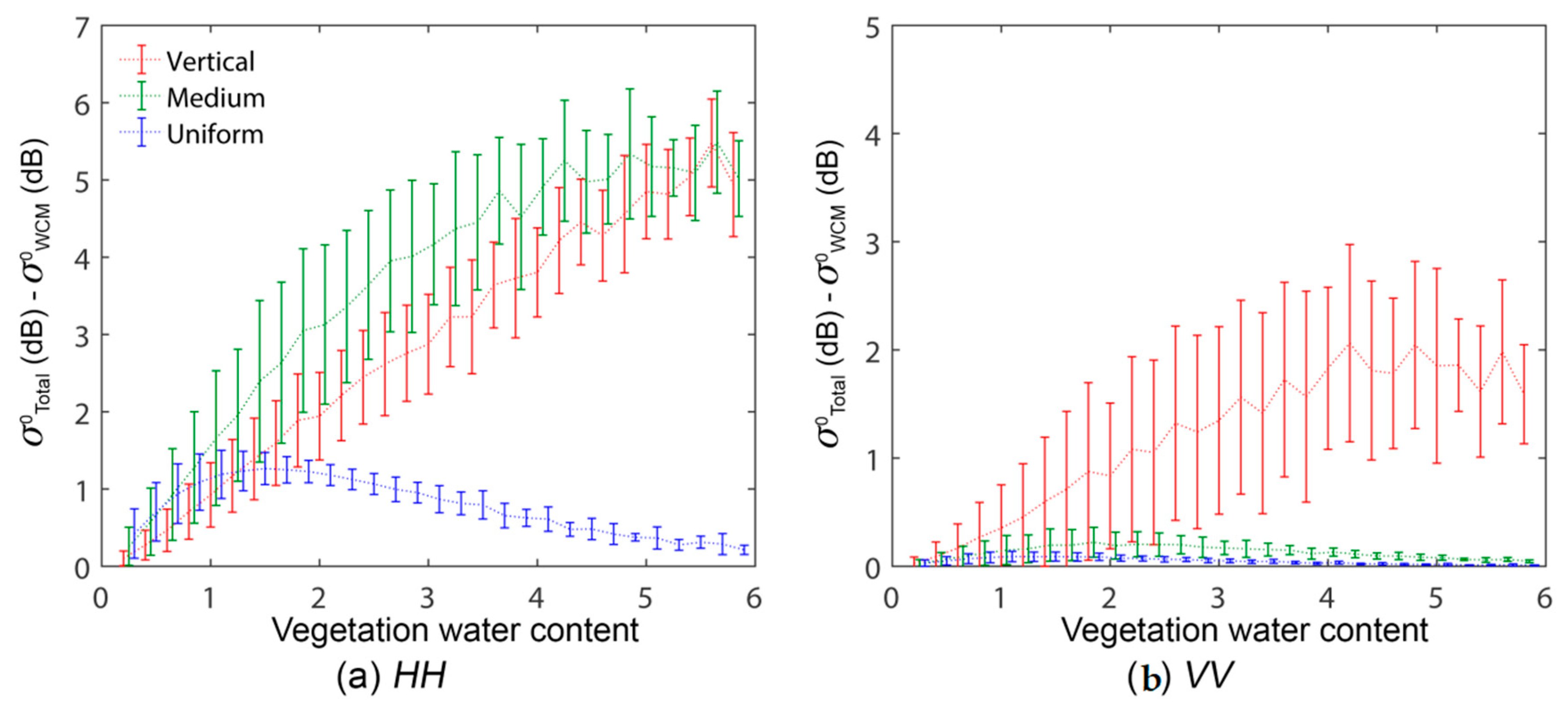1. Introduction
Due to its all-weather imaging and vegetation penetration capabilities, remote sensing of vegetated areas with Synthetic Aperture Radar (SAR) has a great potential for retrieving bio- and geo-physical parameters related to vegetation and the underlying soil surface. The measured SAR signal backscattered from natural targets is given by the superposition of many elementary scatterers. Consequently, in order to estimate physical properties of scatterers from SAR data, it is necessary to investigate different scattering contributions among total backscattered signals by modeling the interactions of microwaves in the vegetated areas.
Theoretical scattering models, such as the discrete scattering model [
1,
2] and the radiative transfer model [
3,
4,
5], have been used to assess the relative importance of microwave scattering mechanisms. In the theoretical models, the vegetation canopy is, in general, represented as an ensemble of randomly distributed dielectric particles, in a layer of specific height, overlying a dielectric ground layer. The total backscatter can be obtained by an incoherent sum of several scattering contributions, including direct backscattering from the vegetation layer, direct backscattering from the underlying rough surface, scattering interaction between the vegetation and the ground surface, and ground–vegetation–ground multiple bounce. The theoretical scattering models have been used successfully to interpret scattering characteristics of vegetated areas and to predict radar signals in relation to the biophysical properties of plants. However, they are usually complex and inconvenient because of a large number of input parameters which lead to complexity in resolving the inverse problem.
To ascertain physical properties of vegetation and soil, a semi-empirical model named the Water Cloud Model (WCM), was proposed [
6]. In the WCM, the canopy is assumed to be a uniform cloud of water like particles. Then, the total backscattered signal is expressed in simplified form, such as an incoherent sum of the backscattering contributions of the uniform canopy layer and the underlying rough surface. Since the canopy in the WCM can be represented by one or two bulk vegetation parameters, it can be practically used for retrieving physical properties. Several studies have used the WCM for soil moisture estimation over vegetated areas [
7,
8,
9,
10,
11] and for biophysical parameter estimation [
12].
In the practical application of WCM, however, parameterization of the simplified model has been the main problem due to the heterogeneity of actual land surface. The WCM tries to express the canopy scattering and attenuation terms in the model by simple vegetation parameters. Several bulk parameters, including Vegetation Water Content (VWC) [
8,
9,
10,
11,
12,
13], Leaf Area Index (LAI) [
7,
9,
11], biomass [
12], and plant water content [
12], have been used as the vegetation descriptors in the literature. Nonetheless, there have been few studies on the selection of the optimal vegetation descriptors in the WCM. Another problem in the parameterization of the WCM is that two unknown model parameters, which relate vegetation descriptors to microwave scattering and attenuation in the canopy layer, have to be determined prior to performing inversion. Studies on retrieving land surface parameters provided site-specific model parameters by regression analysis using field experimental data [
7,
8,
9,
10,
11,
12]. Recently, there were some studies particularly interested in determining model parameters in the WCM, the named calibration of the WCM, for L-band [
13] and C-band [
14,
15,
16,
17] space-borne SAR systems by using in-situ and optical remote sensing data.
This study is dedicated to discussing the aforementioned problems in the parameterization of the WCM. In this paper, the original and improved expressions of WCM are examined and the optimal set of bulk vegetation descriptors is evaluated by using the theoretical model. In addition, the condition-specific regression relationship between bulk vegetation descriptors and theoretical scattering and attenuation coefficients will be analyzed in relation to the vegetation structure. Furthermore, the influence of radar observation conditions on the parameterization of the WCM is investigated. In
Section 2, we review the WCM and discuss how the bulk vegetation descriptors are related to the WCM parameters.
Section 3 presents the effects of shape, size, and orientation of vegetation elements on the parameterization of the WCM. The sensitivity of WCM parameters to observation conditions is discussed concludes this paper in
Section 4 and
Section 5.
2. Water Cloud Model
The Water Cloud Model represents a vegetation layer as a collection of identical spherical particles, uniformly distributed throughout the volume layer. The total backscattering coefficient,
, can be expressed by the incoherent sum of the scattering contribution of the vegetation layer,
, and the scattering contribution of the soil layer,
, attenuated by the attenuation coefficient
, given as follows:
where
and
are the volume backscattering and extinction coefficients of the vegetation layer,
is the vegetation height,
is the incidence angle, and
is the soil backscattering coefficient. Neglecting multiple scattering effects,
and
, can be given by the sum of the backscattering cross section,
, and the extinction cross section,
, of a single particle, such as
where
is the number of particles per unit volume (m
−3). The simplification of the vegetation layer permits the relation of the scattering characteristics to bulk vegetation parameters. In the case of uniformly distributed water particles, the extinction coefficient can be assumed to be proportional to the total water content in the unit volume
(kg/m
3), such as [
6]
In a similar way, the ratio
, which determines the vegetation backscattering coefficient, can be assumed to be independent of water content, such as
However, the simple expressions for the scattering and extinction coefficients in Equations (5) and (6) are only valid for the cloud of water particles. In order to apply the simple vegetation model to practical SAR observations, many researches have used more general expression [
7,
8,
9,
10,
11,
12,
13,
14,
15,
16], such as
The unknown coefficients
and
in the general WCM can be dependent on the canopy type. Since there have been no theoretical basis to determine
and
, they need to be empirically determined. The scattering and extinction coefficients are represented by bulk vegetation parameters
and
. Due to the heterogeneity of vegetation structure, several different sets of vegetation parameters have been proposed in the literature, e.g., VWC, LAI, canopy height (
), and particle moisture content (
).
In order to examine the best set of vegetation parameters and the corresponding
and
, let us firstly assume a vegetation layer consisting of cloud of spherical dielectric particles. The backscattering and extinction cross sections for a spherical Rayleigh scatterer of radius,
, and dielectric constant,
, are [
18]
Here, the dielectric constant of a particle,
, can be related to the gravimetric moisture content,
, through the Ulaby and El-Rayes model [
19], where
and
are the wet and dry mass of a particle. By comparing Equations (1)–(3) and (7), the
and the
terms can be expressed as follows:
To understand the coefficients
and
and the vegetation parameters
and
, variations of
and
terms are examined in relation to several vegetation descriptors, such as the particle moisture content,
, the areal density,
(m
−2), and the VWC (kg/m
2), as shown in
Figure 1 and
Figure 2. The areal density and VWC are defined as
where
is the particle wet density (
kg/m
3, [
20]) and particle volume
.
Figure 1 and
Figure 2 show calculated
and
parameters plotted against different vegetation descriptors. The dielectric constant,
, for calculating WCM parameters is derived from the Ulaby and EL-Rayes model at 5 GHz. It is shown that the
term is highly related to
, while it is independent of particle density. Since it exhibits a quadratic-like dependence on
, the
term can be rewritten in relation to
, such as
Here, the coefficient
varies with the particle size. According to the least square method,
varies from 0.021 for
to 2.6 for
, while
independently with the particle size. On the contrary, the
term exhibits a linear relationship with VWC, as shown in
Figure 2. In this case, we can rewrite the
term as
The coefficient
is not a constant but determined by the moisture content of particles. It varies from 0.27 for dry particles (
) to 0.014 for wet particles (
).
3. WCM Parameters for Non-Spherical Particles
The WCM tries to express complicated canopy backscatters in terms of a small number of vegetation parameters. However, the WCM with identical spherical particles predicts identical co-polarization and no cross-polarization backscatters, which are far from the real SAR observables. In order to figure out more realistic WCM model parameters, backscatter simulations with physical models considering non-spherical particles are presented in this section.
Based on the solution of the radiative transfer equation [
3,
4,
5], the
pq-polarization backscattering contribution of the vegetation layer can be written as
In the case of a canopy layer consisting of randomly oriented dielectric non-spherical particles assuming identical size and shape, the volume scattering coefficient,
, and the extinction coefficient,
, can be obtained by statistical averaging over the scatterer’s orientation distribution
, such as
The orientation distribution of the azimuthal angle,
, and the inclination angle,
, are shown in
Figure 3a. All scatterers are assumed to be distributed uniformly in the azimuth, such as
. For a small non-spherical particle, the scattering amplitude,
, on the incident,
, and scattered,
, directions and the extinction cross section,
, can be calculated by using the Generalized Rayleigh-Gans (GRG) approximation [
21]. It has been widely used (e.g., [
22,
23,
24,
25]) for modeling radar scattering properties from leaves. To evaluate the effects of particle shape, size, and orientation on the parameterization of WCM, two types of vegetation, composed of needle shaped (
Figure 3b) and circular disk shaped (
Figure 3c) particles, are considered in this study.
3.1. Effect of Particle Shape
For non-spherical particles, the constants
and
will vary with polarization. In this study, polarization dependent model parameters will be examined for co-polarization cases, since the cross-polarization signal generally contains no scattering contribution from the soil surface, which has been of great interest in WCM applications. The polarization dependent model constants
and
can be estimated by fitting WCM parameters to the simulation results of the GRG-based physical model. The WCM components are related to the vegetation attenuation and scattering terms of the physical model as
The volume scattering and the extinction coefficients in the left-hand side of the equation are calculated by the GRG approximation. A number of scattering and extinction coefficients of different vegetation, composed of either needles or disks, are simulated using the parameters given in
Table 1. In the simulation, the thickness (
) of needles and disks are set to be 0.1 cm and 0.01 cm, respectively. In addition to the uniform azimuth angle distribution, all scatterers are assumed to be distributed uniformly in the inclination angles, in the calculation of the GRG-based model.
Figure 4 illustrates variations of
and
terms by the GRG-based model with respect to different vegetation descriptors, such as
,
, and VWC. The simulation is performed at 5 GHz frequency. It shows a strong linear relationship between
terms and VWC in both HH- and VV-polarizations, regardless of the particle shape. Consequently, the VWC is selected as the optimal
parameter and the corresponding
coefficient can be determined by the slope of the least square line. Results show that the particle shape affects significantly on the
coefficients of the WCM. A vegetation canopy composed of disk-shaped particles is described by a higher
coefficient than if it is composed of needle shaped particles. In addition, despite the uniform distribution assumption, the estimated
is slightly higher than
in the case of disk-shaped particles. On the other hand, in the case of needle shaped particles, the estimated
is slightly higher than
.
To determine the
parameter and to estimate corresponding
coefficients, variations of the
terms are examined against different vegetation descriptors, as shown in
Figure 5. As with the spherical particle, the
is strongly correlated with the
and exhibits a quadratic-like relationship. Based on a non-linear expression, such as
the
and
parameters can be estimated by least square fit. The estimated
is about 1.9 independently with the particle shape, size, and density. The estimated model coefficient
is affected by particle shape. The disk shaped particle exhibits higher
than the needle shaped scatter. The model coefficients at HH- and VV-polarizations,
and
, are not significantly different in both the disk and needle shaped particles.
3.2. Effect of Particle Orientation
In the previous experiment, non-spherical particles are assumed to be uniformly distributed throughout vegetation layer. However, in many agricultural crops and forests, the scatterers in a volume layer may have a preferred orientation distribution. In order to consider more realistic vegetation structure in the parameterization of WCM, scattering and attenuation coefficients from particles with preferred orientation distribution are considered in this part. The distribution of the inclination angle ) is used to denote the orientation of particles. For simplicity, it is assumed to be a uniform distribution over the interval , such as . When varies in a range around 0°, the needle shaped particles are vertically oriented, while the disk-shaped particles are nearly horizontal.
Figure 6 shows variations of the
coefficients in the oriented volume. Based on previous analysis, VWC is selected for the vegetation descriptor
and
is obtained by fitting the linear function. For the inclination distribution, we consider the three following special cases:
,
, and
. The first case corresponds to the uniform inclination angle distribution, as with the previous experiment. The third case corresponds to either nearly vertically oriented needle or nearly horizontally oriented disk particles.
It is seen from
Figure 6 that the linear relationship between
terms and VWC is maintained throughout different orientation distributions. However, for horizontal disks and vertical needles, oriented volume effects in wave propagation through vegetation layer lead to the differences of the
coefficients between HH- and VV-polarizations. Particularly, the
coefficient, which is associated to the attenuation of HH-polarized signal, is more affected by the orientation of the scatterer than the
coefficient. In comparing needle and disk-shaped particles, the orientation angle effect is more significant in the needle shaped particle. The
coefficient decreases significantly as the needle shaped particle is oriented vertically.
Next, the effect of particle orientation on the
coefficients is evaluated in
Figure 7. As in the previous analysis,
is used for the vegetation descriptor. As with the
coefficients, orientation distribution affects the
coefficients of the needle shaped particle more, especially at HH-polarization. The estimated
coefficients decrease significantly as the needle shaped particles are oriented vertically. In addition, it is seen that the estimated
parameter is influenced by the particle orientation distribution and becomes dependent on the radar polarization. It decreases from 1.9 for uniform distribution to 1.0 in HH-polarization and 1.6 in VV-polarization for the vertically oriented needle. On the other hand, the orientation distribution hardly affects the
parameter in the case of disk shaped particles. The estimated
coefficients slightly decrease as the disk is oriented horizontally.
5. Conclusions
In this study, a comprehensive theoretical analysis of the vegetation parameters in the WCM is presented by examining the relationship between WCM vegetation parameters and the theoretical scattering model predictions. The advantage of implementing the WCM is in being able to express complex scattering characteristics a in vegetated area with simple bulk vegetation descriptors. However, there has been a lack of understanding or consensus about the optimal set of vegetation descriptors denoted by and variables in the WCM. By comparing the theoretical scattering and attenuation coefficients with several vegetation descriptors, the and VWC are selected as the optimal vegetation descriptors for and in the WCM, respectively.
Results show the linear relationship between the VWC and the theoretical model predictions, regardless of the scatterers’ and radar observation conditions. The regression coefficient denoted by in the WCM varies with observation conditions, as well as vegetation structure. A vegetation canopy composed of disk shaped particles is described by higher than the needle shaped particles. In the case of oriented volume, like horizontal disks or vertical needles, the difference of the coefficients between HH- and VV-polarization becomes significant.
On the other hand, there is the power law relationship between the and the theoretical model predictions. Two regression parameters defining the power law relationship, denoted by the and , are also investigated in relation to the various environmental conditions. The parameter varies significantly by the particle shape, size, and orientation. Higher values can be expected in the volume composed of randomly distributed large particles. An interesting part of the term in the WCM is that the form of the power law relationship is also affected by the environmental conditions. It can be a nearly quadratic form in the case of random volume, while the exponent tends to decrease in the oriented volume.
These results provide an insight in the microwave scattering and attenuation process in the vegetation and will be helpful to predict and to interpret the SAR signal in the vegetated areas. Nonetheless, due to the significant variabilities of model parameters, it is still difficult to use the WCM for inversion schemes without in situ experimental data. The relationship between the model constants , , and of the WCM and the vegetation structures suggest the possibility of narrowing down variabilities with the use of prior knowledge of the land-cover where the vegetation layer may have a preferred shape, size, and orientation distribution. Consequently, further evaluation of the inversion of the WCM model will be carried out in future research with the aid of other independent data, such as the optical and multi-frequency SAR data.
